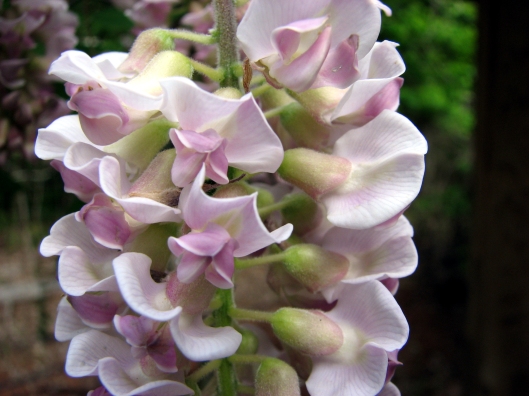Back in late May, 1998, Greg Grant and I were admiring a particular Wisteria frutescens in the SFA Mast Arboretum’s “lines of vines”, a collection of 96 vines on posts. The plant was found by Lynn Lowrey, legendary plant hunter, near the dam of a lake in southeast Texas that was oddly named Dam B. We were discussing the merits of the plant. It had nice-sized blooms for the species, clean foliage, good texture, a little repeat blooming, and had been easy to keep in bounds. There we were scratching our heads for a good name when in a flash, one of those pesky bumble bees made a dive at Greg’s head. He rocked backwards took a swat at the critter and muttered, “Damn bee”. I said, “That’s it! We’ll name it Dam B.” After all, the plant was collected at Dam B. To Greg and I, the name made sense but the problem remained with the spelling. Should we go with “Dam B” or “Damn Bee”? This created a healthy debate on who might or might not be offended. Were there better names out there, or would this grab the public attention to plant more native Wisterias? We never really settled the issue, couldn’t come up with a better name, and the inspiration soon left the both of us so the name ‘Dam B’ stuck. Over the years, the clone has been passed around and can be found in commerce, either as ‘Dam B’, or occasionally as ‘Lowrey’, and rarely as ‘Damn Bee’.

‘Dam B’ sports light blue/lavender, finely scented, pendulous flowers in six-to-ten inch long racemes that mix perfectly with the fine-textured foliage. This plant enjoys a heavy flowering season in late May and June and then blooms lightly and sporadically throughout the summer and into the fall. Pruning and deadheading certainly encourages repeat blooming. Our specimen “on a stick” was easy to keep in bounds and the suckers from the crown are easy to take care of in comparison to their Asian cousins.

Wisteria frutescens ‘Dam B’

‘Dam B’
This selection of Wisteria frutescens has been with us many years and I have seen it at other locations; it’s a promising candidate for the southern gardener wanting a less rambunctious vine with wisteria-like charm. There are other Wisteria frutescens to consider. ‘Amethyst Falls’ out of Head-Lee Nursery in South Carolina remains a popular standard, sports dark bluish purple popcorn like blooms and is popular because it never sets seed which allows it to bloom repeatedly. We have Wisteria frutescens ‘alba,’ the white flowering form and another seedling in the Arboretum. ‘Memphis Blue’ enjoys a long true blue inflorescence. ‘Longwood Purple’ is another dark flowered popcorn bloom form. Our collection also includes three selections by Maarten van der Giessen of Best Liners of Semmes, Alabama and they look strong. Our latest acquisition is a “pink” form found by Peter Loos and Matt Welch several years ago near Pascagoula, Mississippi. While not a sizzling hot pink, there’s enough pink there to give us hope for future selections.

Wisteria frutescens ‘Peter’s Pink’ really is kind of pink

‘Peter’s Pink’
Wisteria frutescens is native, hardy, drought-tolerant and much better behaved than those closely-related, yet less civilized Asian cousins, Wisteria floribunda, the Japanese wisteria and Wisteria sinensis, the Chinese wisteria. The main problem with these two brutes is growth rate. A vigorous Chinese or Japanese Wisteria can become a monster if left untended for very long (like overnight). Root suckers can gain an incredible foothold far from camp. Plant Wisteria frutescens.
Propagation is easy. Softwood cuttings under mist in June and we have had good success with hardwood cuttings taken in late winter. All Wisterias appreciate full sun, a well-drained soil and good horticulture during the establishment years. A three year old vine is here to stay, quite capable of dealing with heat, drought, cold, floods, and the gardener’s neglect and occasionally, abuse. Tough plants for a tough place on earth.

This is an outstanding piece of information. Thanks!
LikeLike
Where can I get a Peter’s pink wisteria???????? Been looking everywhere!
LikeLike
Where can I purchase Dam B wisteria vine?
LikeLike